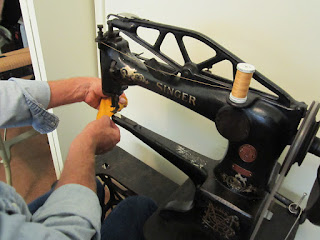 |
| 1905 Singer 29K-4 |
 |
| Gustave Dore, 1965. "Destruction of the Leviathan" |
I found downloadable manual free of charge through the Singer Company. Click this link: Singer 29K manual
Does it even work? Well yes it does, but it took some getting used to. The learning process is still going on. It is quite different than a regular lockstitch in two ways: The presser foot works as the feed from the top and the presser foot can be manipulated to move in different directions. The reasons for this has to do with the primary function it was designed for. That would be very close work as with shoe repairs. It makes a lot of noise when operating but it is a pleasant one. It sounds like "work". Clank clank clank.
As an example of it's work, see the image below. With this pair of shoes, the stitching was coming apart at the bottom side and the overlapping part. I was able to reinforce the stitches along the bottom then completely turn it to go the flap. It did an excellent job and saved a favorite pair of Minnetonka shoes. This would have been a tricky job even by hand because of the tight space at the bottom. Very cool, very cool indeed.
 |
| The presser foot moves by moving this brass handle. |
 |
| Singer 29k Stitch Sample |
The bobbins are very small and so is the machine arm. This is what it looks like with the cover removed.
The design is to allow access to tight spaces and that has been very very handy a few times. A drawback is that it also makes this less practical for doing very large things that need support. There was a table extension available for these when you purchased them back when new. There are plans for making them now and I may do that someday. The time that would have been useful to have was when I was making a bag. Holding it was a bit awkward on that tiny arm space. This is what the extension table looked like as sold originally
Anyone who finds this post and is wondering how it's threaded may take note of this next section. First, get a manual. You NEED it to explain the bobbin loading and threading. Simply put, it is not like other machines and you are not going to figure it out on your own. The outside threading is easy to see but this part was a little confusing to me so here's a picture to clarify.
The thread is pushed down this hole after it leaves the tensioner. It goes all the way down to the presser foot.
You will need a threader like this. There is a tiny hook at the end to hold the thread as you push it down. Give yourself a lot of extra thread for this, as it can be very tiresome to keep having to re-do it.
 |
Once you get familiar with the machine it is a kind of interesting thing to behold. It is very masculine. Of all the machines here this is the only one that my husband actually touched. He was even the first one to use it. Go figure. Is it worth having? Of course I always say yes but this one has a very different purpose than the others. So far it has been very useful for repairs, less so for creativity. If you fix heavy things, then maybe you could use this. If you just want to make things than maybe not. That said, I have made a few things with it that would have been very difficult otherwise, like these little shoes. What's another machine anyway.
My leviathan, it is a beautiful beast.







